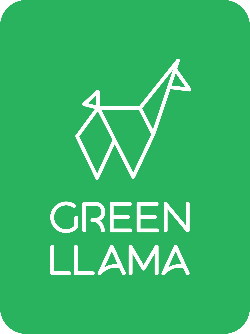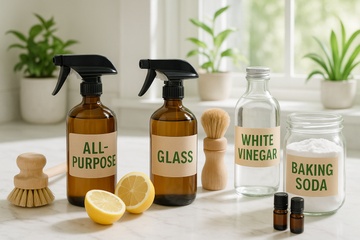Non-Toxic Cleaning Products: The Ultimate Guide for a Healthy Home
by Kay Baker on Oct 09, 2025
Healthy Home Guides
Non-Toxic Cleaning Products: The Ultimate Guide for a Healthy Home
Transparency note: Educational overview with references to public programs and guidance. Not medical or legal advice. We update as standards evolve.
Feeling lost in the world of "green" cleaning? You're in the right place. One walk down the cleaning aisle can feel like a pop quiz you didn't study for, with confusing labels, leafy green packaging, and vague promises that don't quite add up. It leaves you wondering: What's actually safe for my home? And does "natural" even work?
We believe that creating a healthier home shouldn't be confusing. It should be empowering.
That's why we created this guide. Think of it as your trusted, A-to-Z resource for everything you need to know about natural cleaning. We’re here to cut through the clutter, bust the myths, and give you the confidence to transform your home, one smart choice at a time.
What Are Natural Cleaning Products? (A Simple Definition)
Let's make it simple. Natural cleaning products are cleaners whose power comes from ingredients that are sourced from nature. Instead of harsh, synthetic chemicals manufactured in a lab, they rely on:
- Plant-Derived Ingredients: e.g., vegetable-based soaps, organic acids from citrus.
- Mineral-Based Ingredients: e.g., baking soda, sodium carbonate, salt.
Ultimately, it’s less about a strict definition and more about a philosophy: choosing cleaners that are effective without compromising your family or the planet — with ingredient transparency you can trust.
The "Why": 7 Core Benefits of Making the Switch
- A Healthier Family. Fewer harsh chemicals can reduce exposure to irritants and potential toxins.
- Safer for Kids & Pets. Clean confidently around curious hands and paws.
- Better Indoor Air Quality. Skip strong fumes; many natural cleaners are unscented or lightly scented.
- Protecting Our Planet. Biodegradable ingredients help reduce aquatic pollution when properly used and disposed.
- Less Plastic Waste. Refill systems cut single-use bottles.
- Gentle on Your Home. Tough on grime, friendlier to finishes when used as directed.
- Surprising Cost Savings. Concentrates and refills can lower cost per use versus water-heavy sprays.
The All-Star Ingredients: Your Natural Cleaning Toolkit
- White Vinegar: Helps dissolve hard-water deposits and soap scum. Avoid on natural stone.
- Baking Soda: Gentle abrasive and deodorizer.
- Castile Soap: Versatile, plant-based soap for surfaces and floors.
- Hydrogen Peroxide (3%): Useful for whitening/brightening and stain treatment. For disinfection, use an EPA-registered product and follow label contact time.
- Essential Oils: Can add scent; some have documented antimicrobial activity. Pet note: use cautiously around pets (especially cats) and ventilate.
Decoding the Labels: How to Become a Savvy Shopper
Look beyond the front label. Read ingredient lists, watch for the “fragrance” catch-all, and learn a few trusted programs:
Want a deeper framework? See our 5-point checklist in the Buyer’s Guide to the Best Natural Cleaning Products.
Your Path to a Greener Clean: The DIY vs. Done-for-You Routes
The DIY Route: Crafting Your Own Cleaners
Fun, economical, and fully transparent—DIY gives you total control, with a bit of testing and time investment. Start with our Ultimate Guide to DIY Cleaning Recipes.
The "Done for You" Route: Choosing the Right Products
Prefer convenience and precision? Professionally formulated products bring balanced pH, validated performance, and easy refills. Use the Buyer’s Guide to evaluate claims.
Your Room-by-Room Natural Cleaning Quick-Start Guide
- Kitchen: For greasy splatter, spray an all-purpose cleaner, wait ~60 seconds, then wipe with microfiber.
- Bathroom: For soap scum on glass, spray undiluted vinegar, wait 10–15 minutes, scrub with a non-scratch sponge. Avoid stone.
- Floors: For most sealed floors (not unsealed wood), add a small amount of plant-based soap to warm water for residue-free mopping.
- Laundry: Skip fabric softeners. Try wool dryer balls to soften and reduce dry time.
Our Commitment to a Truly Clean Future: The Green Llama Way
We didn’t just write this guide; we built our company on these principles. We list every Safer Choice-aligned ingredient we use, we test for real performance, and our zero-waste refill system with durable bottles and compact refills is designed to eliminate single-use plastic.
Explore the All-Purpose Starter Kit
FAQs
Do natural products work as well as conventional ones?
Yes—when well-formulated and used as directed. Look for brands that publish ingredients, reference third-party programs, and share performance testing.
Does “natural” mean non-toxic?
Not automatically. “Natural” is not a regulated term in cleaning. Evaluate the full formula, hazard information, and credible third-party programs.
Is vinegar a disinfectant?
Vinegar cleans but is not an EPA-registered disinfectant. For disinfection, use an EPA-registered product and follow label contact times.
Trust & Reader Support
- 24-hour correction pledge: If you spot an error, we’ll review and update this article within 24 hours.
- Contact CX: hello@greenllamaclean.com
References (reader-friendly)
- U.S. EPA — Safer Choice & DfE-certified disinfectants
- EWG — EWG VERIFIED™
- Leaping Bunny — Cruelty-Free Standard
- USDA — Certified Biobased Program
- CDC — Home cleaning vs disinfecting guidance





